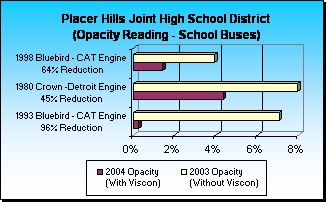

Field Tests
Test Results for Cleaner Burning Fuel
| Smoke Opacity Testing Certified Staff |
|
|
|
|
Extending DPF Re-generation Intervals and Saving Fuel
|
|
Diesel Particulate Filters (DPF) are proven and effective devices for removing soot Particulate Matter (PM) from hot diesel exhaust. The substrate material lines these filtering devices in order to remove the exhaust soot created by normal diesel engine combustion.
The soot buildup in the DPFs must be periodically removed in a passive or active way. If it is not removed according to the manufacturers’ recommendations it will plug and cause serious engine damage.
|
|
Obviously this creates an added expense not only in fuel and operator costs but also down time during the work day.
Reducing the amount of PM from the exhaust and prior to the DPF process clearly reduces these cost factors; i.e., less PM for the DPF to process and less DPF re-generation intervals. Reducing fuel consumption at the same time is an added, much desired, benefit.
Click here to see Viscon’s results
|
|
|
Smoke/Opacity Readings
|
|
From a community perspective, smoke is the most tell tale observation of pollutants. The perception of diesel engines has long been one of a “belching old junk pile.” If the smoke can be reduced, the perception will change. Fuel treated with Viscon has proven to achieve better opacity readings.
|
|
Placer Hills Joint Unified High School District participated in a grant awarded to Viscon by the California Placer County Air District. Opacity readings were conducted by Evenson’s Smoke Testing using Red Mountain Engineering computerized equipment. All engines passed compliancy.
|
|
|
|
|
|
Electric Motor Propelled Ship
|
|
The Hope and Mersea are sister ships, identical in all ways. In a voyage made at the same time by the two ships, to and from a destination, Hope was fueled with Viscon treated fuel, Mersea used plain diesel. The ships are powered by diesel engines turning generators which supply electric power to propel the ships.
|
|
Since all ambient weather and sea conditions were the same for the two ships, they were able to compare engine performance by comparing the amount of work required to move the ships on their voyage. The average engine RPM required to move the Hope was about 14% less than for the Mersea.
|
|
Fuel Economy Tests
|
School Buses
9% Reduction |
|
|
Hazardous Waste Transport
& Remediation
6% Reduction |
|
|
Oil Services Construction
6.3% Reduction |
|
|
|
|

-- CARBON CREDITS --
Converting CO2 To Energy
Capturing CO2 and improving thermal and volumetric efficiency reduces emissions that would otherwise exit the exhaust into the atmosphere. The quality of each carbon credit is determined by the standards and methodology of the project. High quality credits are the result of following stringent, scientifically proven governmental protocols for emissions testing.
Individual and Corporate social responsibility requires High Quality CO2 projects in their carbon footprint strategy. Viscon Carbon Credits exhibit permanent nonreversible Scope 3 CO2 emission reductions generated in the USA. The additional GHG emission reductions places these in the category of a Super Offset Credit.

Copyright © 2018, VisconUSA. All rights Reserved





